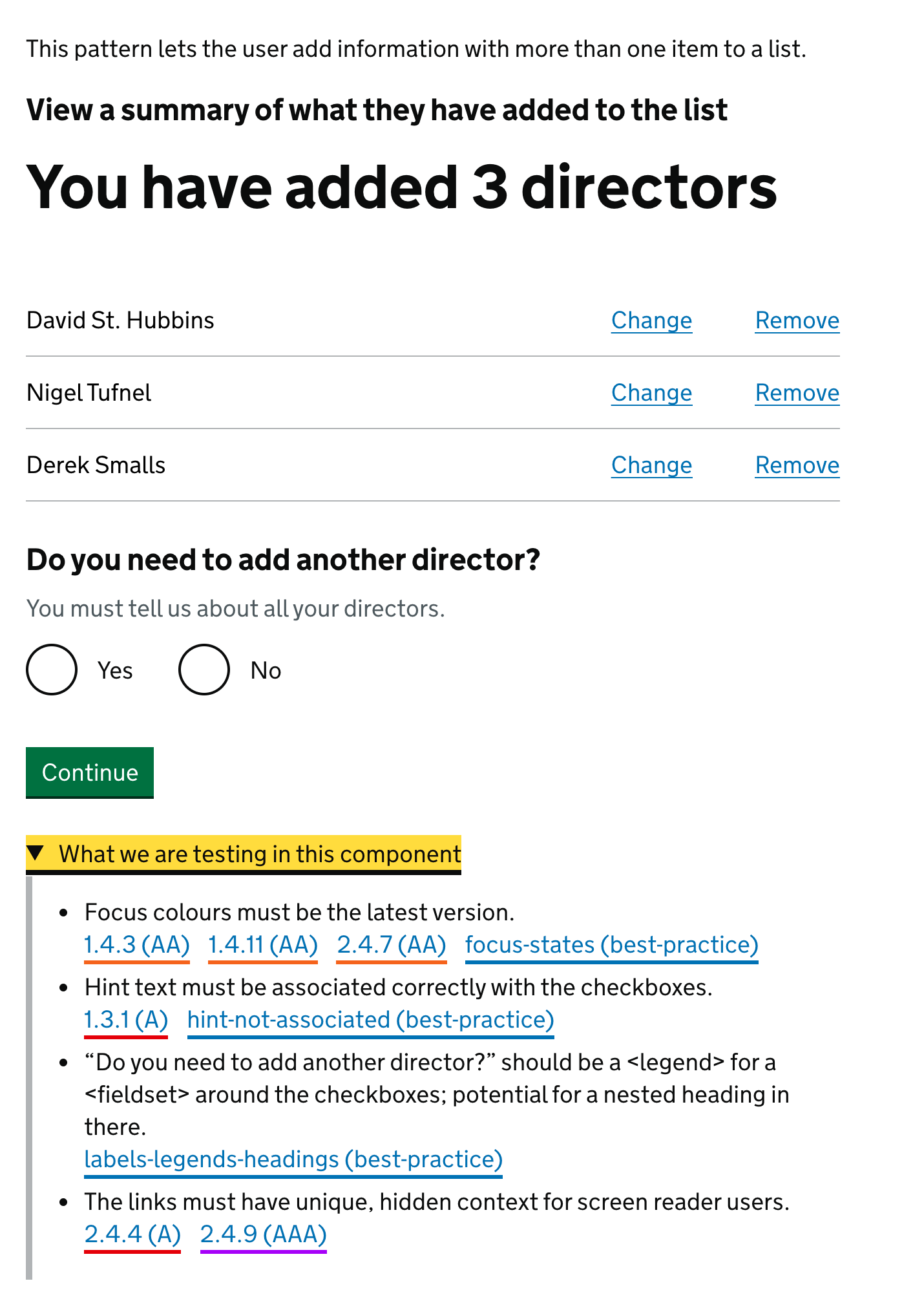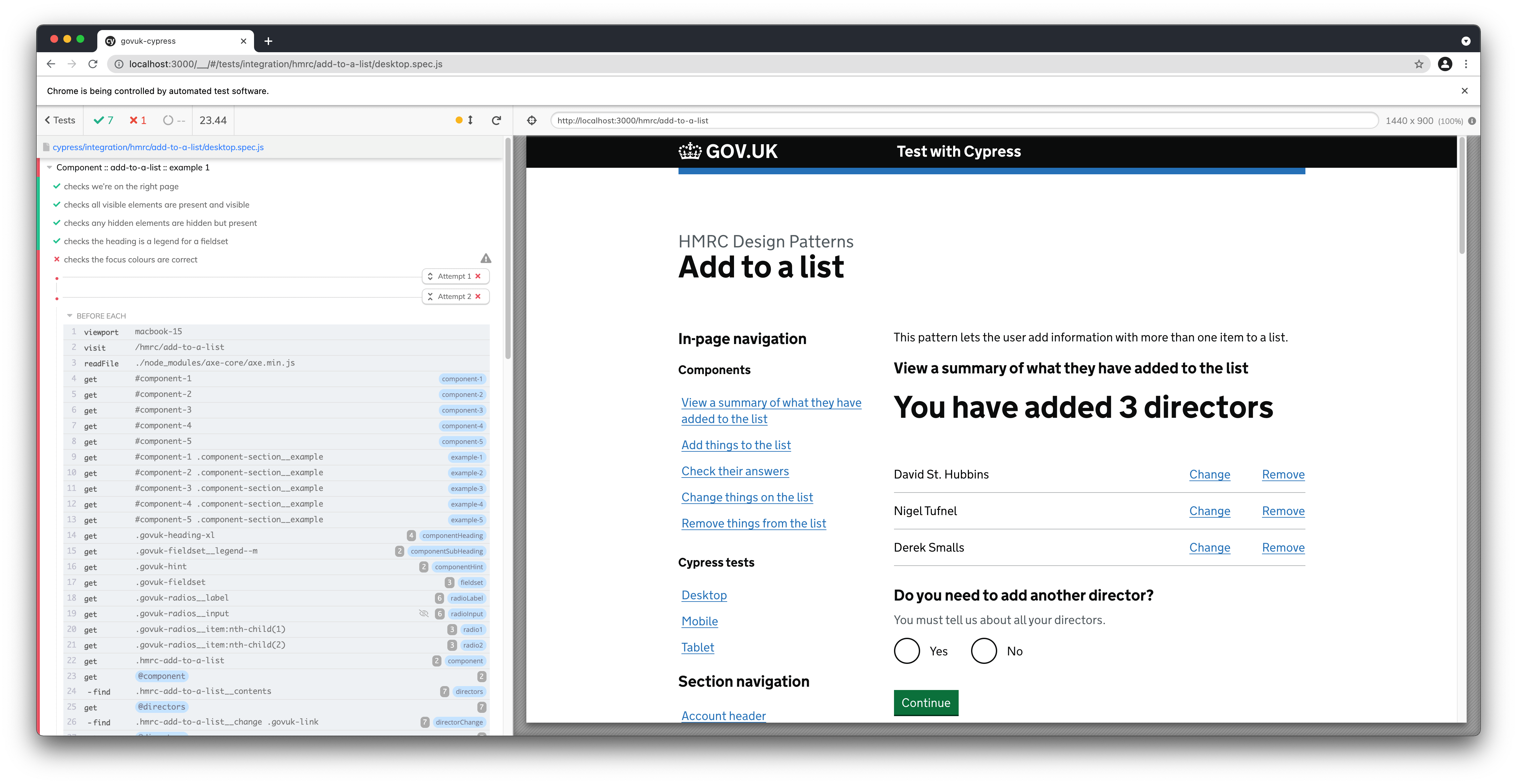A demonstration of how to use the Cypress framework to test GOV.UK & HMRC components and patterns.
Install instructions are further down. Read about it first.
This is not a replacement for the tests that come with the GOV.UK Prototype Kit—far, far from it.
This is not something that you will have to install into your service to see results. (Although, that part will come later.)
This is an educational project to promote better accessibility knowledge when using these components in your daily job.
This repository includes working examples of Cypress tests based on components that you are familiar with. You can use these as a starter to get writing even more for your own services.
“To promote testing in a way that makes people think about accessibility as they use these components in their daily jobs.”
I’ve added the examples of each component from the GOV.UK Design System and HMRC Pattern Library, but then added a details section underneath. This is where the education (hopefully) kicks in.
Not everyone knows what they should be testing, so it’s no surprise that so many services arrive at the accessibility team in the state they do and get sent back to the service team with a long list of issues to fix. So, my idea is that teams can read through this and have a better understanding of what they need to pay attention to, in order to put them in a better position to deliver a good service.
“To try and target which tests can be pulled out into a plugin for people who regularly use these components.”
I’ve already written each test separately, but maybe there are some components or patterns where you think you could help out; or, even better, improve what’s here.
Because I’m just one person, I’m hoping that there might be some traction here and others might pick up a few other components, or patterns. Besides, I’m rubbish at this.
URL: http://localhost:3000/hmrc/add-to-a-list
Using the “Add to a list” component as an example, shown in the image below, there is a details component which contains a list of what we’re wanting to test. I’ve recreated that here:
What we are testing in this component
- The focus colours must be the updated version.
- The hint text must be associated correctly with the checkboxes.
- “Do you need to add another director?” should be a `legend` for a `fieldset` around the checkboxes; potential for a nested heading in there.
- The links must have unique, hidden context for screen reader users.
Cypress is heavily based on Mocha and Chai, so if you’ve used those before you’ve already got this.
Use the beforeEach() block to set up aliases for the elements that you’re testing, which can be scoped to describe() blocks to keep things tidy and keep your cognitive load low.
Written in clear English, these instructions are tucked away in components.js and pulled in for each component example.
Because these are things that we have to do time and time again, I’ve made each one a separate Cypress Command that you can call:
cy.get("@component").click().checkFocusColours();cy.get("@component").checkAriaDescribedBy();cy.get("@component").checkHeadings();cy.get("@component").checkLinkContext();
These are called from within a Cypress spec file. I’ve chosen to split these up into three files to allow for the relevant viewport checks:
desktop.spec.jstablet.spec.jsmobile.spec.js
The viewport variables are a built-in Cypress thing, which I’ve dumped into a small file (env.json), but you can find them all here: viewport - Cypress documentation.
{
"desktop": {
"viewport": ["macbook-15"]
},
"mobile": {
"viewport": ["iphone-6"]
},
"tablet": {
"viewport": ["ipad-2", "portrait"]
}
}I’ve also put together an example.user.json file which will most likely come in handy for testing as the examples fill up. Rename to user.json and amend this as you see fit.
{
"username": {
"firstName": "",
"middleNames": "",
"lastNames": ""
},
"dateOfBirth": {
"year": "",
"month": "",
"day": ""
},
"address": {
"addressLine1": "",
"addressLine2": "",
"addressLine3": "",
"city": "",
"county": "",
"postcode": "",
"country": ""
},
"contactDetails": {
"emailAddress": "",
"phoneNumber": "",
"mobileNumber": "",
"voiceCall": "false"
},
"bankDetails": {
"bankName": "",
"branchName": "",
"branchCode": "",
"accountHolderName": "",
"accountNumber": "",
"sortCode": ""
},
"passportDetails": {
"passportNumber": "",
"expiryDate": ""
},
"taxCreditsDetails": {}
}Once everything has been put together into the one file, it:
- checks we’re on the right page
- checks all visible elements are present and visible
- checks any hidden elements are hidden but present
- checks the heading is a legend for a fieldset
- checks the focus colours are correct
- checks the link context
- screenshots the component for a diff state
- runs axe against the component
Most of the output is shown in the Cypress browser.
The output from axe is currently configured to log to the console, rather than cause things to stop dead. Here’s what you can expect from that:
1 accessibility violation was detected
| (index) | id | impact | description | nodes |
|---|---|---|---|---|
| 0 | 'duplicate-id-aria' | 'critical' | 'Ensures every id attribute value used in ARIA and in labels is unique' | 3 |
This whole project started because I’d been using Cypress a fair bit lately, so I’d been looking at ways to reuse code. I’d also seen a large gap in how people are testing their work during my two years of auditing services on the accessibility team.
A service team has used the Design System to scope out some components and patterns for the service they're building, but their version of the Play Framework is old and they have to manually copy/paste a bunch of stuff to manually recreate things in a less-than-optimal way. (These things happen.) One thing they didn’t manage to do, was bring over the latest focus states. But now, by running cy.get("@component").click().checkFocusColours(); in their tests, they’ll get that flagged before they get anywhere near the accessibility team.
There have been too many times when I saw an error summary pattern where the links had no matching targets, or the links were ordered in an illogical way. The Error summary pattern is unique enough to GOV.UK services that it made sense to have a specific test which checks that each link in the summary box has a corresponding target in the page, and in the same order. cy.get("@component").checkGovukErrorSummary(); checks for all of these things.
You get the picture.
While there are a few tests at the moment, they’re nowhere near perfect and PRs are welcome to improve things.
cy.checkPageTitle();Cypress function to check the page title has the correct elements, with an argument to bypass when the page has personally identifiable information.cy.get("@component").click().checkFocusColours();Cypress function to check the focus colours match the latest GOV.UK Design System.cy.get("@component").checkLinkContext();Cypress function to check each link has enough unique context for screen reader users to understand its purpose.cy.get("@component").checkAriaDescribedBy();Cypress function to check anyaria-describedbyvalue has a valid target in the page.cy.get("@component").checkAriaLabelledby();Cypress function to check anyaria-labelledbyvalue has a valid target in the page.cy.get("@component").checkGovukErrorMessage();Cypress function to check each error message on the page conforms to the standards set by the GOV.UK Design System.cy.get("@component").checkGovukErrorSummary();Cypress function to check each error summary link has a valid target in the page.cy.get("@component").checkHmrcCurrencyInput();Cypress function to check the HMRC Currency Input pattern.cy.get("@component").checkHmrcPageHeading();Cypress function to check the HMRC Page Heading pattern.cy.get("@component").checkHmrcTimeline();Cypress function to check the HMRC Timeline component.
The components that will be tested are from HMRC’s Design Patterns and GOV.UK’s Design System. This is very much a work in progress (using the GOV.UK Prototype Kit), so feel free to raise a PR and pitch in.
- Accordion
- Back link
- Breadcrumbs
- Button
- Character count
- Checkboxes
- Cookie banner
- Date input
- Details
- Error message
- Error summary
- Fieldset
- File upload
- Footer
- Header
- Inset text
- Notification banner
- Panel
- Phase banner
- Radios
- Select
- Skip link
- Summary list
- Table
- Tabs
- Tag
- Text input
- Textarea
- Warning text
- Account header
- Accounts office reference
- Add to a list
- Ask the user for their consent
- Confirmed identity
- Could not confirm identity
- Currency input
- Employer PAYE reference
- HMRC banner
- Internal header
- Match an organisation to HMRC records
- Notification badge
- Page heading
- Page not found
- Page title
- Service timeout
- Service unavailable
- Sign out
- Status tags in Task list pages
- There is a problem with the service
- Timeline
- Unique Taxpayer Reference
- VAT registration number
- Welsh language toggle
- Clone the repo:
gh repo clone philsherry/govuk-cypress - Install the dependencies:
npm install - Install Cypress:
npm run cypress:install - Start the server:
npm start - Visit the page in your browser:
http://localhost:3000 - Open Cypress to run some tests:
npm run cypress:open
To help those in design and front-end who use Visual Studio Code instead of IntelliJ, there are some additional files in this repository.
extensions.json: recommends a set of extensions to help with a Scala development environment, as well as debugging and linting tools, and things to generally help you commit more consistent code. Run these from in the Workspace Recommendations section of the Extensions sidebar.launch.json: a set of debug configurations to help debug your code with the help of various browsers and tools. Run these from in the Debug sidebar.

